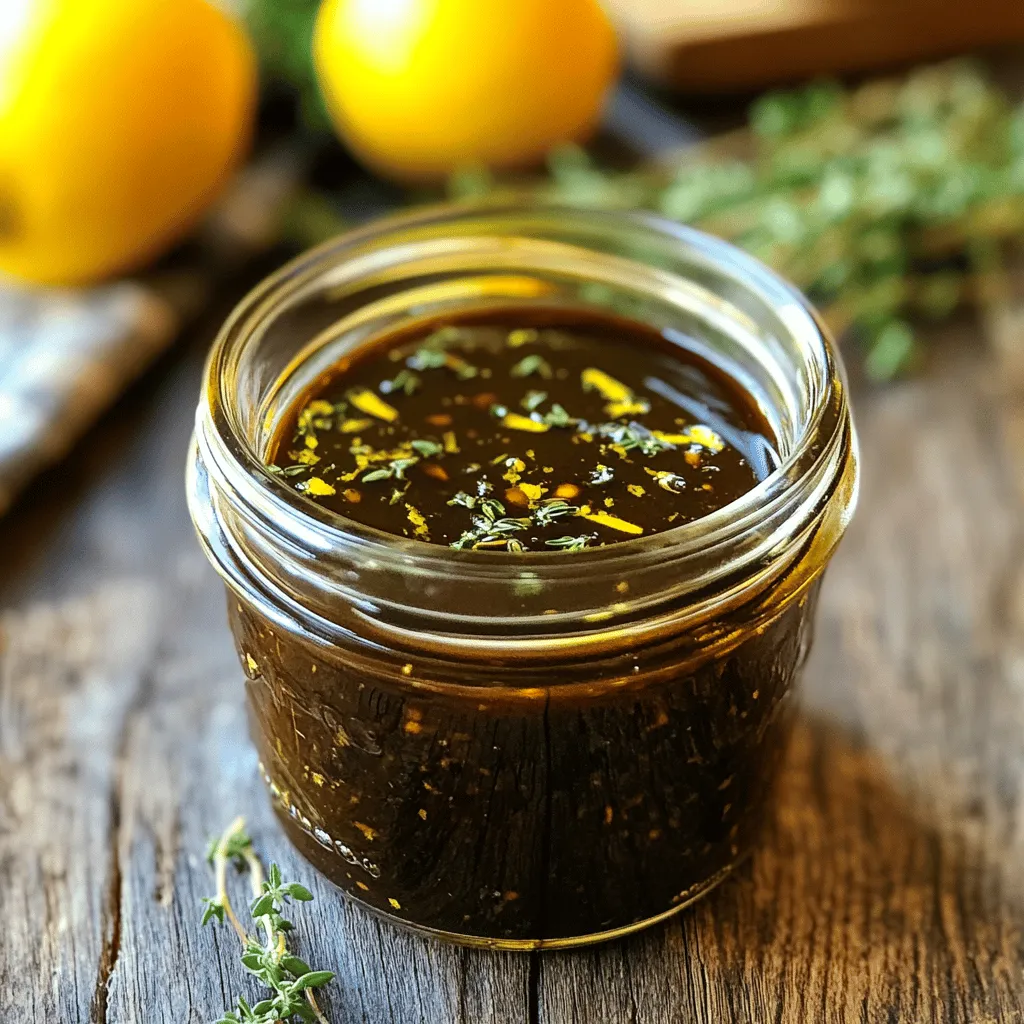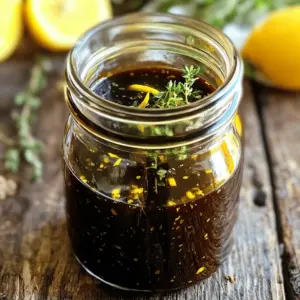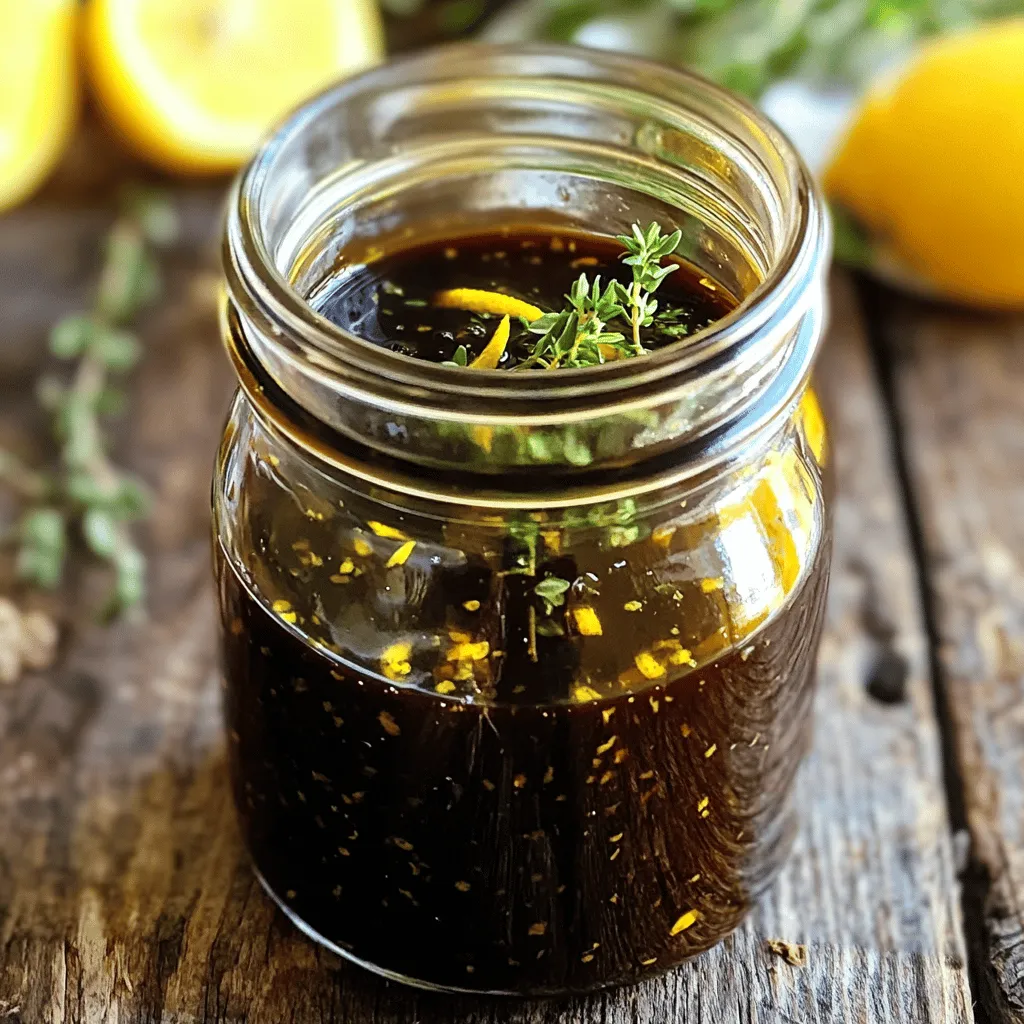Are you ready to elevate your salads with a homemade balsamic vinaigrette? In this simple and flavorful recipe, I’ll guide you through the essential ingredients and easy steps to create your own dressing. Whether you’re seeking a fresh twist for your lunch or a tasty dip for veggies, this vinaigrette has you covered. Let’s dive in and make salad dressing exciting again!
Ingredients
Essential ingredients for Balsamic Vinaigrette Dressing
To make a great balsamic vinaigrette, you need a few key items. Here’s what you will need:
– 1/2 cup balsamic vinegar
– 1/2 cup extra virgin olive oil
– 1 tablespoon Dijon mustard
– 1 tablespoon honey or maple syrup
– 1 clove garlic, finely minced
– Salt and freshly ground black pepper, to taste
– 1 teaspoon fresh thyme leaves (or 1/2 teaspoon dried thyme)
These ingredients blend together to create a rich, tangy flavor. The balsamic vinegar gives a sweet and sour taste. The olive oil adds a smoothness that balances the acidity.
Optional additions for flavor enhancement
You can add extra ingredients to make your vinaigrette even better. Here are some ideas:
– 1 teaspoon lemon zest for a bright twist
– A pinch of red pepper flakes for heat
– Fresh herbs like basil or parsley for a fresh touch
Each of these additions can change the taste and make the dressing unique. Feel free to experiment with what you like best!
Alternative sweeteners and oils
If you want to switch things up, you can try different sweeteners and oils. Instead of honey, you can use:
– Agave syrup for a vegan option
– Maple syrup for a richer flavor
For oils, consider using:
– Avocado oil for a light flavor
– Walnut oil for a nutty taste
These alternatives can help you find the perfect balance for your taste buds. If you’re curious for the full recipe, check out the Zesty Balsamic Vinaigrette above!
Step-by-Step Instructions
Easy-to-follow preparation process
Making balsamic vinaigrette is quick and simple. First, gather your ingredients. You’ll need balsamic vinegar, extra virgin olive oil, Dijon mustard, honey or maple syrup, minced garlic, salt, pepper, and fresh thyme.
1. Start by mixing the balsamic vinegar, Dijon mustard, honey, and minced garlic in a bowl. Whisk these together until they blend well.
2. While whisking, slowly add the olive oil. This step helps create a smooth dressing.
3. Once it’s thick and creamy, add in the fresh thyme and optional lemon zest. This will give your vinaigrette a bright flavor.
4. Taste your mix and add salt and pepper to your liking. Adjust sweetness with more honey if needed.
5. Pour your vinaigrette into a jar. Close it tightly for storing in the fridge. Shake well before each use.
Tips for achieving the perfect emulsion
To make a great vinaigrette, focus on the mixing. Add the oil slowly while whisking. This helps the oil combine with vinegar. If you pour too fast, it won’t thicken. Keep whisking until it looks creamy.
If you want to use a blender, that’s fine too! Just blend the ingredients until smooth. This method also gives a nice emulsion.
Ways to personalize your vinaigrette
You can change your vinaigrette in many ways. Add herbs like basil or oregano for different tastes. Want some heat? Try red pepper flakes!
You can also swap the sweetener. Use agave syrup instead of honey. If you like a tangy taste, add more mustard. Don’t forget about different oils too. Try avocado oil for a buttery flavor.
For a fun twist, mix in some fresh fruit puree or juice. This can give your vinaigrette a unique flair. The options are endless!
For the full recipe, check the section above.
Tips & Tricks
How to store your homemade dressing
Store your balsamic vinaigrette in a clean jar with a tight lid. Keep it in the fridge to stay fresh. It will last up to two weeks. Always shake it well before each use. This helps mix the oil and vinegar together again.
Best practices for using vinaigrette in salads
Use just the right amount of dressing to coat your greens. A little goes a long way. Start with one to two tablespoons per serving. Drizzle it over your salad and toss gently. This ensures every bite has flavor. You can also use it as a dip for veggies or bread.
Common mistakes to avoid when making vinaigrette
One mistake is adding too much oil or vinegar. This can make your dressing too greasy or too sharp. Always taste as you go! Another common error is skipping the emulsification step. Slowly whisking in the oil helps create a creamy texture. Follow the Full Recipe for the best results!

Variations
Flavor variations to try
You can easily change up your balsamic vinaigrette. Try adding fresh herbs like basil or oregano. A splash of orange juice can give it a bright twist. You can also mix in a bit of mustard for added zest. If you like heat, add a pinch of red pepper flakes. For a sweeter touch, consider using fruit purees like peach or raspberry.
Serving suggestions for different cuisines
This vinaigrette works well with many dishes. For Italian meals, drizzle it over Caprese salad. For a Greek touch, add it to a salad with feta and olives. If you’re making a stir-fry, use it as a marinade for chicken or tofu. You can also pour it over roasted root vegetables for a warm side dish. It adds life to any meal!
Dietary substitutions for health-conscious options
If you’re watching your sugar intake, swap honey with a sugar-free sweetener. Use a low-sodium soy sauce instead of salt for flavor without the added sodium. For a vegan option, replace honey with maple syrup. If you want a lighter vinaigrette, reduce the oil to 1/3 cup and add a little water for balance. You can still enjoy a delicious taste while keeping it healthy.
Storage Info
How to properly store balsamic vinaigrette
To keep your balsamic vinaigrette fresh, place it in a glass jar or bottle. Make sure the container has a tight lid. This helps prevent air from getting in and spoiling the dressing. Always shake the jar before each use. This step helps mix the ingredients back together since they may separate over time.
Shelf life and signs of spoilage
Homemade balsamic vinaigrette lasts about one week in the fridge. After this time, check for signs of spoilage. If you see any mold or notice an off smell, it’s best to throw it away. A change in color may also indicate it has gone bad. Always trust your senses when it comes to food safety.
Tips for maintaining freshness
To keep your vinaigrette fresh longer, use clean utensils each time you scoop some out. Avoid dipping anything directly into the jar. If you want to store it longer, consider freezing small portions. You can freeze it in ice cube trays and use one cube at a time as needed. This way, you’ll always have fresh dressing on hand. For the full recipe, check out the Zesty Balsamic Vinaigrette.
FAQs
What is the nutritional value of balsamic vinaigrette?
Balsamic vinaigrette is low in calories. One tablespoon has about 40 calories. It contains healthy fats from olive oil. This dressing also offers small amounts of vitamins and minerals. The balsamic vinegar adds antioxidants, which help fight free radicals.
Can balsamic vinaigrette be used as a marinade?
Yes, balsamic vinaigrette makes a great marinade. It adds flavor to meats and vegetables. Use it on chicken, fish, or tofu. The acidity helps tenderize meats, making them juicy and tasty. I often marinate my veggies before grilling for extra flavor.
How long can I keep homemade balsamic vinaigrette?
You can keep homemade balsamic vinaigrette for about one week. Store it in the fridge in a sealed jar. Shake it well before each use, as it can separate over time. If you see any changes in color or smell, it’s best to toss it out. For the full recipe, check the earlier section.
In this post, we covered essential ingredients for balsamic vinaigrette and step-by-step instructions to make it. I shared tips for storage and common mistakes to avoid, plus tasty variations to try. The right dressing can transform salads and dishes. Remember, great taste comes from quality ingredients and a bit of practice. Use what you love and feel free to experiment. Enjoy making your own vinaigrette that suits your taste and health goals!

